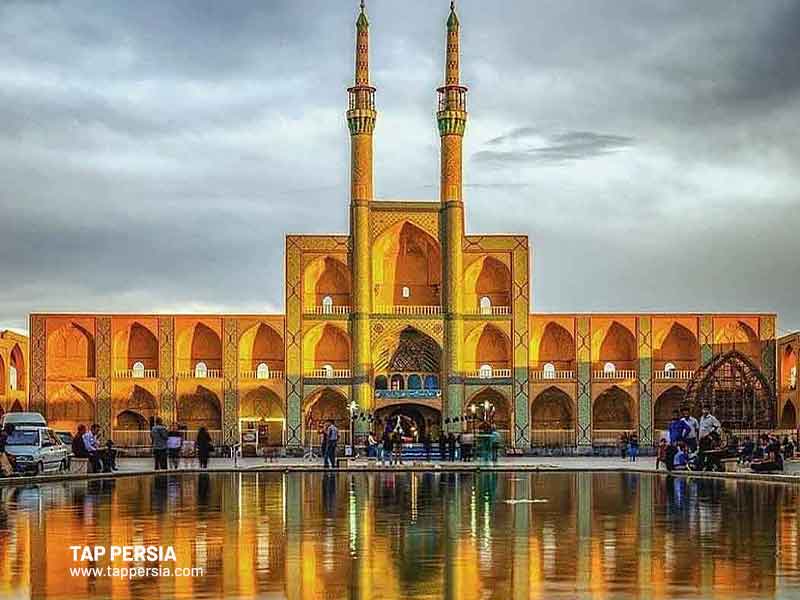
The desert city of Yazd is home to several historical sites from Iran’s prehistoric era. The ancient monuments, including the enormous structures with breathtaking architecture, display Iran’s rich culture and civilization over the course of its many millennia-old history. Located in the heart of Yazd’s ancient district, the Amir Chakhmaq Complex is one of the city’s most significant tourist destinations. It is one of the most notable historical structures in the country.
The locals and visitors to this city congregate in this field to bask in its splendors, and while the fountains dance, they will also catch a glimpse of a little of the history of this old nation.
History of Amir Chakhmaq Complex
Places like Tekyeh and Hosseinieh are typically located in the middle of neighborhoods in Yazd, along with other amenities like the water storage, bath, mosque, market, caravanserai, etc. The Amir Chakhmaq complex is no exception to this rule and adheres to the same structural pattern as the other buildings in the city.
Amir Jalaluddin Chakhmaq, the ruler of Yazd in the eighth century, makes the decision to construct a number of mosques, marketplaces, and other structures in this region of the city in order to boost Yazd’s economic development. You may utilize the vehicle rental in Iran services in this city since this plaza, which is known as Yazd’s emblem, is situated along Salman-Farsi Boulevard and has an appropriate driving path.
During the Safavid era, this square was well-known with the same name. Some of Amir Chakhmaq’s intricate works have been rediscovered during the reign of Shah Abbas. Hosseiniyeh is the name of the square in front of the mosque and market hall as of the early thirteenth century.
Of fact, as similar locations have been common in Iran since the Safavid era, what is definite at that time is that this location does not play the function of Hosseiniyeh. A cemetery was established in the Amir Chakhmaq compound during the Qajar era. However, they put a stop to it in the Pahlavi region, and with the destruction of the tombs, it once more took the shape of a square.
The intricate facade of Amir Chakhmaq, which has a cuprous dash and sculptures, has recently grown more beautiful and alluring. You can notice a large palm tree in the corner of this plaza, which has been there since the Safavid era and is utilized in the Muharram ritual, one of the most significant ceremonies in Iranian culture.
The Architecture of Amir Chakhmaq Complex
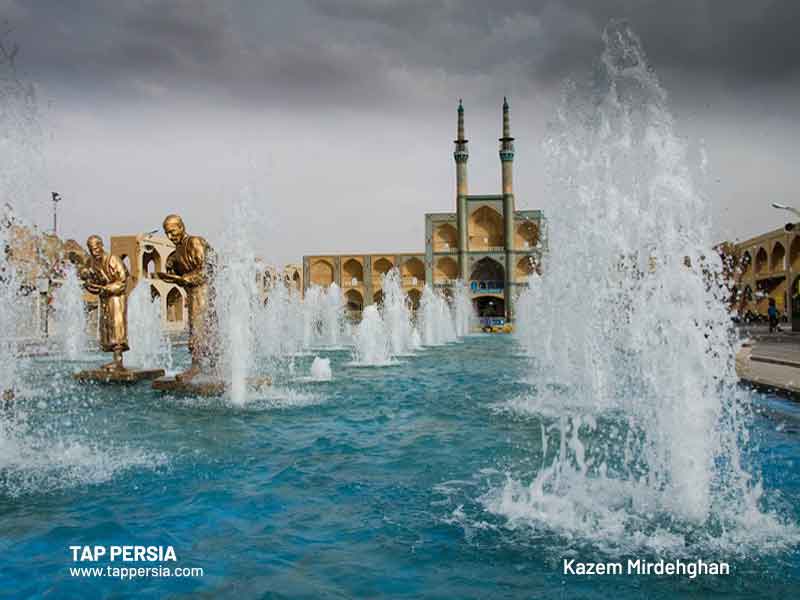
You will feel tranquil thanks to the inviting atmosphere of the three-story façade at the end of the plaza and the start of the bazaar. The copper-colored sunshine is captured by each properly sized arched alcove, showing the great talent and skill of Persian architects.
If you want to observe the lights and bricks game, attempt to arrive there in the evening. The environment is given a flavor of watery lighting by the lit fountains.
Amir Chakhmaq Mosque
Amir Chaghmaq Mosque also went by the titles of Duhok Mosque and New Grand Mosque. The mosque in this plaza was built during the Timurid period by Amir Jalaluddin Chaghmaq Shami and his wife Seti Fatemeh Khatoon, who were the governor of Yazd and one of the rulers and commanders of Shahrokh. It is the oldest building there. The Amir Chakhmaq Mosque, Yazd’s second mosque, is the most stunning and impressive. The building of this mosque began in the year 841 AH and is now complete. This mosque’s porch entry is embellished with mosaics and tiles, some of which include inscriptions. Additionally, the mosque’s main altar is constructed of Mogharnas structures and is covered in mosaic tiles. The marble at the altar’s center is expertly sculpted. An intriguing feature of the Amir Chakhmaq Mosque is that it contains two naves, one for the summer and one for the winter, which are used in accordance with the weather. The endowment letter’s content has been inscribed in Naqrbar script on a stone that has been set in front of the mosque’s entrance on the building’s portion that faces Amir Chakhmaq Square. On the south side of the square, this mosque is located.
Small mosaic tile nets have been put in the windows on the north corridor’s side. Its rafters are brick-colored, and a portion of the porch plate’s entry is mosaic. The words “Sultan Zal Allah…” are repeated in Kufic brickwork on the dome’s belt and around the dome’s exterior. The main mosaic tile stage of the altar is made up of the Mogharnas structure, a square flower measuring 54 x 95 cm in the middle of the Mogharnas, and a marble in its left hand. 28 x 30 cm is the size that it is installed in.
Mosaic tile inscriptions of Muhammad al-third Hakim’s line may be seen on the east wall of the mosque. The mosque’s dome is curving, covered in cracks of green tile, and has an inscription in Kufic script all around it. Haji Hossein Attar expanded the mosque’s nave and made repairs to other areas of the building under the rule of Fath Ali Shah Qajar.
Haji Ghanbar Bazaar
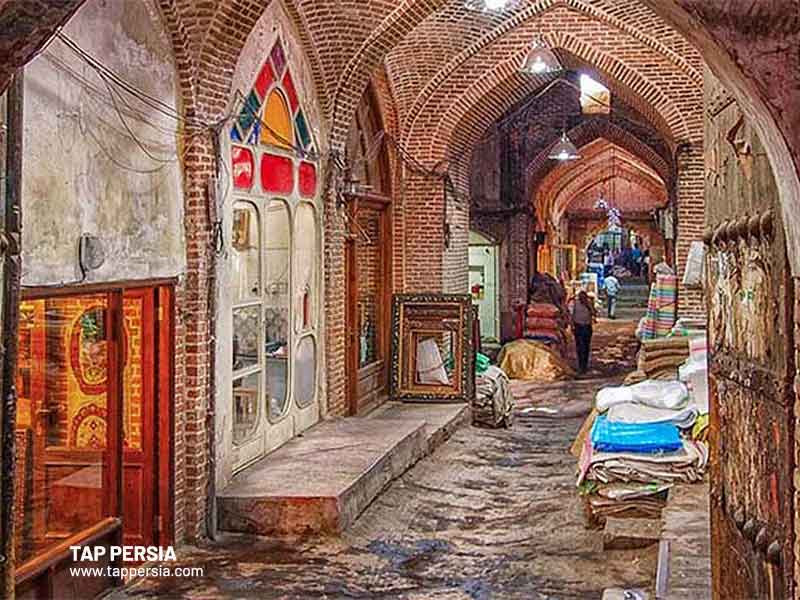
Yazd has a large bazaar, much like every other Iranian city, and it serves as the city’s economic backbone. The market was divided into two pieces and some of its most important locations were tragically destroyed with the building of Shah Street (now known as Ghiam Street) during the Pahlavi dynasty.
Sales in this bazaar’s northern section are now going quite well. The largest collection of carpet, gold, candy, and fabric retailers may be found here. Haji Ghanbar Bazaar is the name of the oldest section of this bazaar, which is found in its easternmost section.
Nezamoddin Haji Ghanbar Jahanshahi, one of the Yazd kings, was the building’s constructor, and his name is referenced in the name. In Haji Ghanbar Bazaar, you may find some treasured reminders of the Islamic calendar’s ninth century. There are also various shops that produce natural products like textiles, colors, and sweets made from sesame. Yazd crafts may be found in abundance there as well.
Amir Chakhmaq Tekyeh
Amir Chakhmaq Tekyeh is a beautiful building that you can see in most images of the compound. A Tekyeh is a structure that features several terraces for spectators to use to see religious rituals or significant occasions.
It’s unknown when Amir Chakhmaq Tekyeh was born and what role he played historically. But that doesn’t stop its architectural brilliance from gleaming amid the complex. Standing in the plaza, one is treated to a beautiful view of the two central minarets, the graceful high head, the forecourt, the dome, and the terraces.
The front has three stories of neatly constructed alcoves and was constructed with mudbrick and exquisitely adorned stucco. The most prominent people of the city used to sit in the center alcoves, which had a greater altitude and elaborate tilework. In the past, you could climb to the Tekyeh’s summit and take in the scenery of Yazd’s historic monuments. However, as of right now, only the first level is accessible to the public.
The Historical Palm of Amir Chakhmaq
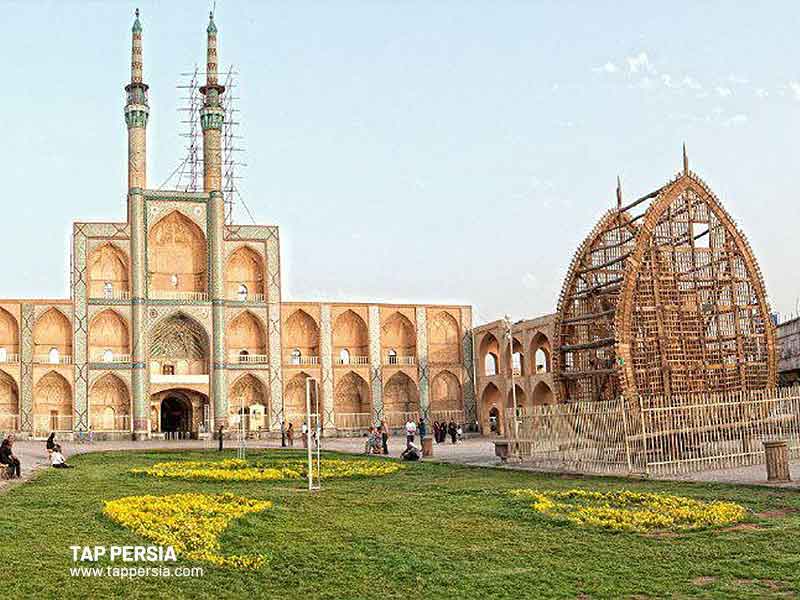
The enormous, historically significant palm tree known as the Heydari palm or “Nakhl” is situated to the east of Amir Chakhmaq Square and is another notable historical aspect of the area. Experts estimate that this palm has been there since the Safavid era, or around 450 years ago, and some people think it could be the oldest palm tree still standing.
In a ritual known as palm carving, participants carry this enormous wooden coffin on their palms. This palm tree’s overall shape is that of a cypress tree, symbolizing independence. It is composed of a lattice set of carved wood with porcelain knots and big beams.
Seti Fatemeh Khatoon Mausoleum
The wife of Amir Chakhmaq, who has made significant efforts to promote this area, is known by the name Seti Fatemeh Khatoon. She is the originator of a very beautiful and sizable collection. Her tomb is situated in the northern section of the area and dates to the ninth century according to the Islamic calendar. The inside of the building has mosaic and muqarnas on a stucco foundation, while the dome includes green tile work.
Amir Chakhmaq Water Storage
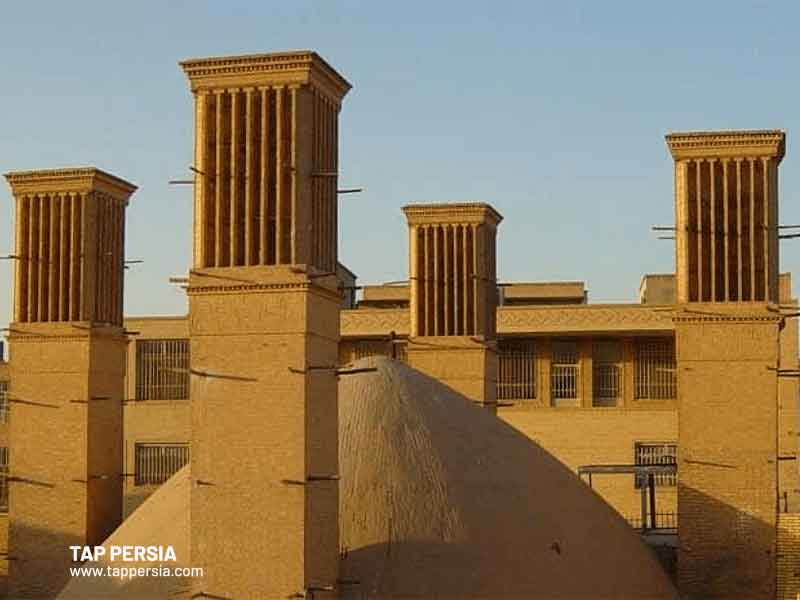
In Amir Chakhmaq Square, there were formerly three water storages, but one of them was lost to time, leaving just the other two. In the absence of a water pipe network, they were still in use until roughly 40 years ago. Since that time, they have fallen into obscurity, and their purpose has changed.
The Wind Towers (BaadGir)
As you stand in the Amir Chakhmaq Complex (Amir Chakhmaq square) and turn your head, you may see two remaining wind turbines proudly displaying themselves from rooftops.
The Pleasant Nights
Amir Chakhmaq Square is pro-nightlife, in contrast to many other locations in Iran. In Yazd, the plaza takes on a different mood when dusk falls. Yazdi families congregate in the plaza to spend a nice evening together as the fountain and the Tekyeh alcoves are artistically lighted.
Other Areas Worth Visiting in Amir Chakhmaq Complex
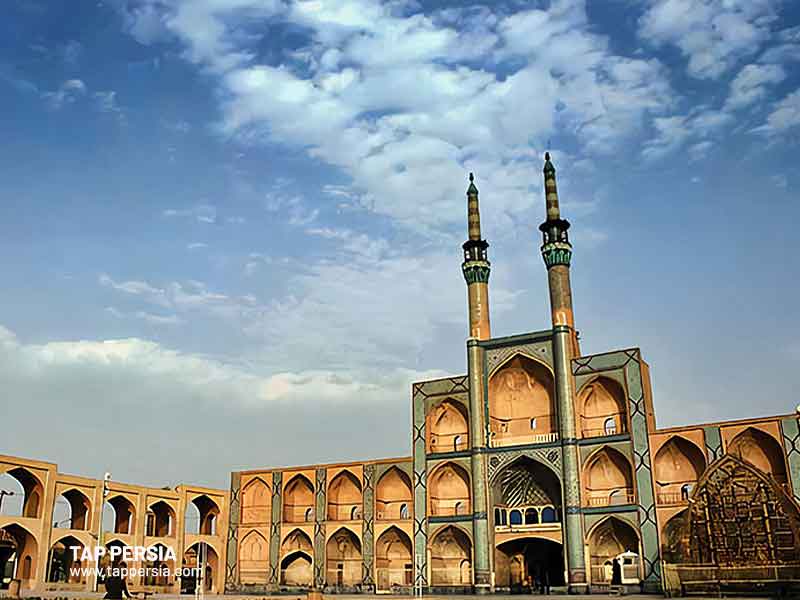
Amir Chakhmaq Square has a few other less noticeable areas besides the many primary areas we have already explored. There are public baths, caravansaries, and other facilities in addition to historical elements like the copper statues in front of the pond and fountain. Additionally, a few tombs of unidentified Holy Defense martyrs have been placed recently to foster a spiritual environment.
Accommodation near Amir Chakhmaq Square
The lodging options close to Amir Chakhmaq Square include the traditional Yazd Traditional Hotel, the Malek-o Tojjar Hotel (4 stars), the traditional Vali Traditional Hotel (3 stars), and the traditional Firoozeh Traditional Hotel (3 stars). The Mehr Chain Hotels Group’s hotels offer the best accommodations in Yazd.
Restaurants Near Amir Chakhmaq Complex
You have a few options for neighboring restaurants to eat at, including Baharestan Restaurant, Yazd Traditional Restaurant, Hamila Burger, and Karizma Café & Restaurant.
How to Get To Amir Chakhmaq Complex
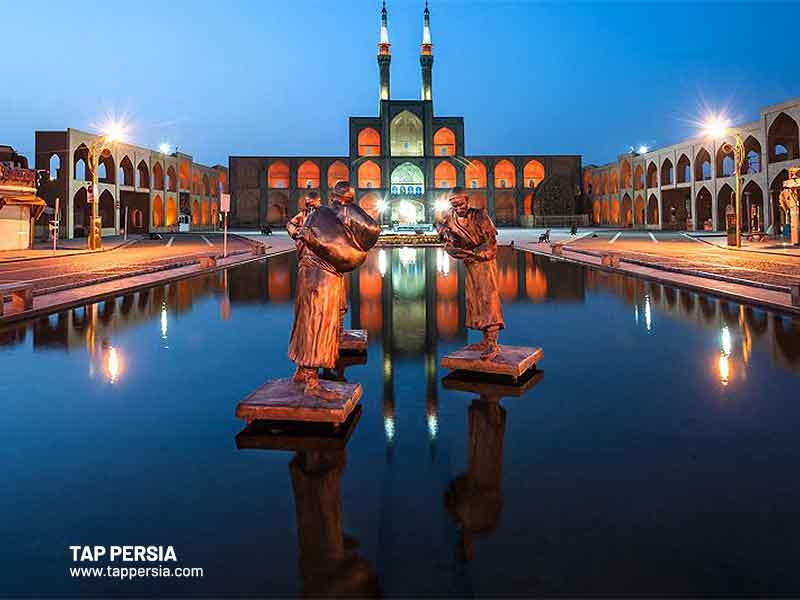
There are two ways to actually get to the Amir Chakhmaq complex:
By Car
Regardless of whether you are traveling down Imam Street, Ghiam Street, or Salman-e Farsi Street, you may see the gorgeous Amir Chakhmaq Square throughout your trip.
On Foot
You may travel down Salman-e Farsi Street and stroll around Amir Chakhmaq Square admiring its lovely monuments.
Frequently Asked Questions about Amir Chakhmaq Complex
While we have covered important aspects of the Amir Chakhmaq Complex, there might be some information left for you to know more about. Here are a few questions and answers for extra information regarding this magnificent complex:
When is the Best Time to Visit the Amir Chakhmaq Complex?
Avoid going to Amir Chakhmaq, Yazd, Iran, during the scorching months of July or August, if possible. After all, it is a desert city. The greatest times to travel are in the spring and fall.
When is Amir Chakhmaq Complex Open?
Amir Chakhmaq Complex is open from Sun – Sat 12:00 am until 11:59 pm.
Which Attractions are in Close Proximity to the Amir Chakhmaq Complex?
The Amir Chakhmaq Complex is not far from the Yazd Water Museum. The Zoroastrian Fire Temple is only a four-minute drive from the complex, while Dolat Abad Garden is only a seven-minute drive away. Shirdal Airya, the Oasis gallery, and Saheb A Zaman Zurkhaneh are other attractions worth visiting in Yazd.



Comment (0)